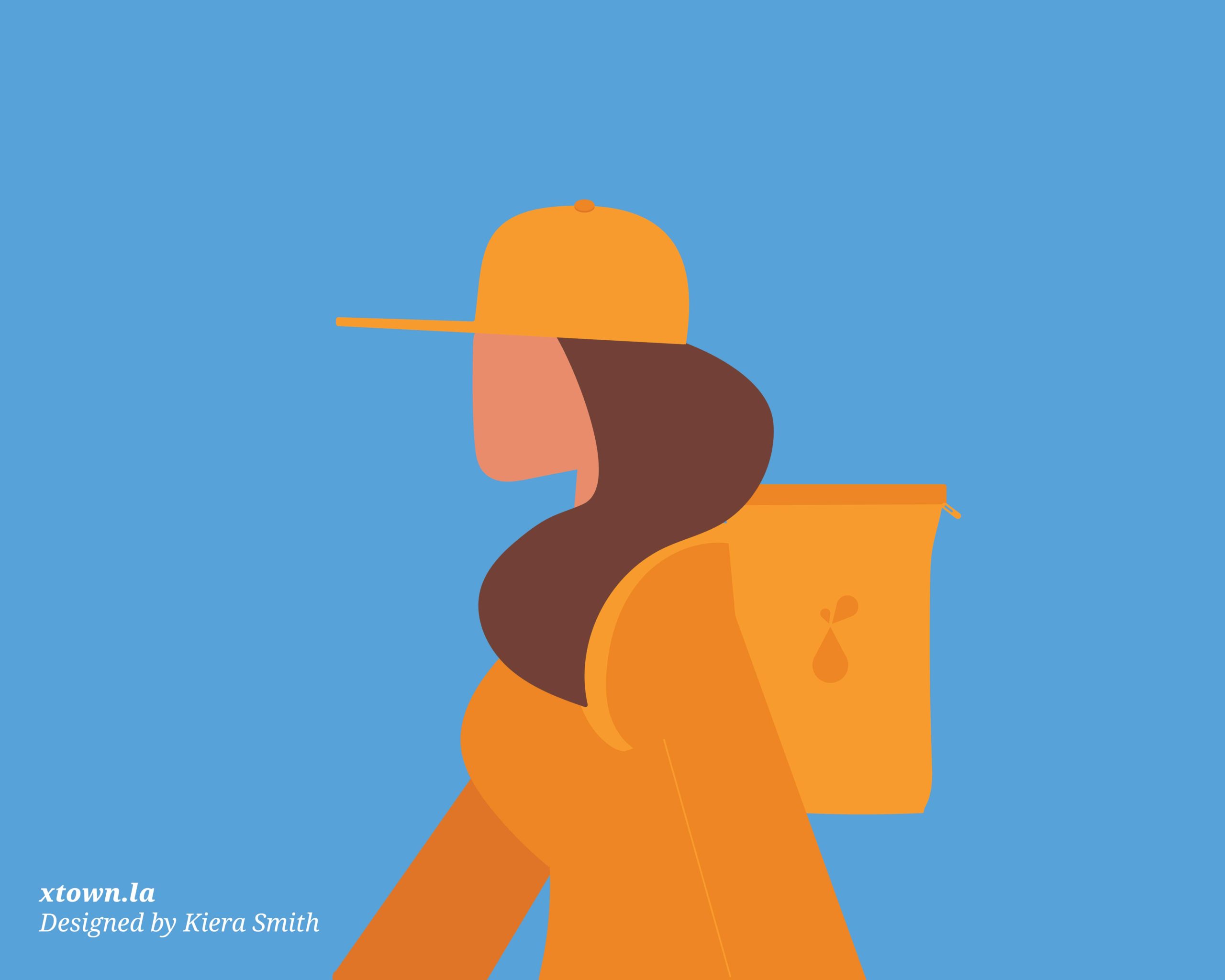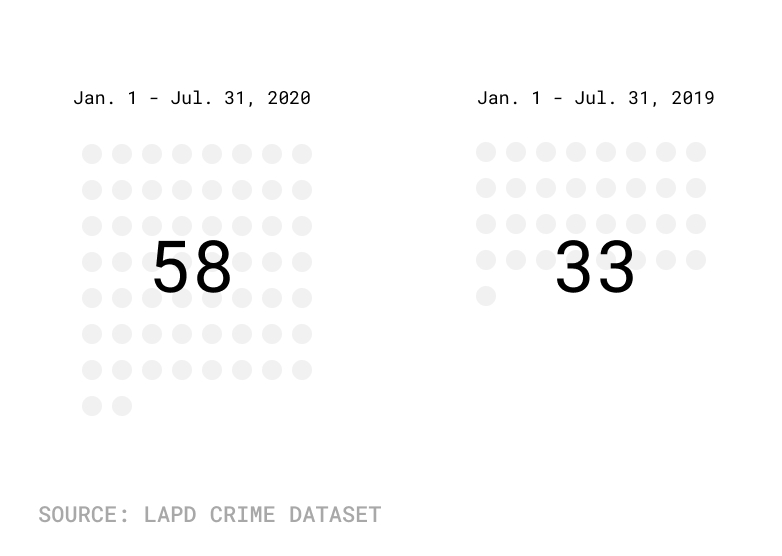Making deliveries can be a risky business

With the coronavirus pandemic forcing people to stay home, the use of delivery services for everything from restaurant meals to pet food has soared. So have the risks the many workers making those deliveries now encounter.
In the first seven months of the year, 58 delivery personnel have been the victim of a crime, according to Los Angeles Police Department data. In the same period last year, there were 33 incidents.
Reports of crimes against delivery workers in Los Angeles

The trend shows no sign of slowing down. As of Aug. 16, the LAPD had recorded 66 crimes against delivery people. That surpassed the 62 reports in the entirety of 2019. In 2018 there were 49 crimes committed against delivery people.
From Jan. 1 – July 31, 25 delivery people were the victim of a robbery, making up nearly 43% of all crimes reported against delivery people in that time, according to the LAPD. There were 13 assaults, accounting for nearly 20% of incidents.
Safe delivery
Alex Graff, who spends an average of 20 hours per week delivering for the app DoorDash, said the increase in attacks on delivery persons is “frightening” and makes her hesitant to deliver, but she will continue.
“I’m particular about the orders I accept so I only put myself in safe situations,” said Graff. “I choose to deliver in very busy parts of L.A. with a lot of restaurants, apartment buildings. I don’t get caught alone often, which makes me feel safe.”
Sebastian Robinson, who delivers for Postmates, said he has never been attacked, but is cautious while on the job.
“If I had a choice, I wouldn’t do it,” said Robinson. “I only started again because my unemployment benefits stopped.”
Crime is hardly the only hazard delivery people face. The frequent contact they have with restaurant workers, supermarket employees and the people taking delivery of their packaged places them at an elevated risk of exposure to COVID-19.
A package deal
This year, Amazon has increased grocery delivery capacity by 160%, and it saw an online sales boost of 40% during its second quarter, according to the company. Although Uber rides have decreased due to people staying home, its food-delivery service is up, Chief Executive Dara Khosrowshahi told Wall Street analysts in a conference call in July, according to NPR. The company is increasing its bet on delivery, purchasing Postmates this year in a $2.65 billion all-stock deal.
Domino’s Pizza has also committed to filling 20,000 positions, many of which include delivery drivers, according to a press release.
Robinson said he has noticed an increase in business in Los Angeles, with fewer peak patterns and more consistent orders across the day.
Los Angeles is not the only place where delivery personnel have been at risk. Attacks on Amazon drivers have been reported in cities including Atlanta, San Francisco and Gary, Indiana.
The increase in attacks has delivery companies thinking about safety more than ever. Caesar Natividad, operations manager at Deliver LA, emphasizes that personnel should use common sense while on the job and that drivers should secure their vehicles when making deliveries. He added that if a driver is uncomfortable going to a certain area, the business will hand the delivery to another person who is.
Natividad, who has been in the delivery industry for 33 years, could only recall one instance, back in the 1980s, when a driver was attacked.
“He was a black belt and he was able to take the knife away from the guy,” said Natividad.
Tony Zenteno, manager of A-1 Courier in Los Angeles, echoed Natividad’s sentiment regarding safety precautions and said the company has been fortunate not to have any personnel attacked. He noted that he looks to hire people “who are great at avoiding confrontation.”
Robbery, assault
Historic South-Central recorded five attacks this year, the most of any neighborhood, according to the LAPD. That included an incident at 6:15 p.m. on March 31, when multiple people knocked a 53-year-old delivery person to the ground, kicked and robbed him at the intersection of Avalon Blvd. and 41st St.
At 8:15 p.m. on June 23, a suspect wearing a hoodie and a mask used a semi-automatic pistol when ambushing a delivery driver on the 200 block of E. Martin Luther King Jr. Blvd. Investigations into both incidents are ongoing.
Manchester Square and Sylmar have each seen four instances of a delivery person being attacked this year, according to the LAPD.
In addition to safety, many food delivery drivers in California are contending with other potentially disruptive changes to their work.
Rideshare Drivers United, an independent association founded in Los Angeles, which represents drivers who deliver for platforms like UberEats, is currently seeking to have Uber and Lyft recognize their union. They hope to be able to negotiate on behalf of drivers for better wages and more transparency, according to their website.
The association also wants voters to reject Prop 22, a referendum that will appear on the November ballot, that would grant Uber and Lyft exemptions from state laws and require the companies to provide drivers with fair wages, healthcare, sick leave, and other labor protections. Advocates for Prop 22 said drivers want to remain independent contractors, rather than become full-time employees of the businesses because it gives them more control and flexibility over when, where and how they work.
How we did it: We examined LAPD publicly available data on reported attacks on delivery persons from Jan. 1 – July 31, 2020, compared with the previous year. For neighborhood boundaries, we rely on the borders defined by the Los Angeles Times. Learn more about our data here.
In making our calculations, we rely on the data the LAPD makes publicly available. On occasion, LAPD may update past collision reports with new information, or recategorize past reports. Those revised reports do not always automatically become part of the public database.
Want to know how your neighborhood fares? Or simply just interested in our data? Email us at askus@xtown.la.






